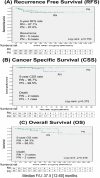Recurrence after radical and partial nephrectomy in high complex renal tumor using propensity score matched analysis
- PMID: 33536492
- PMCID: PMC7859240
- DOI: 10.1038/s41598-021-82700-8
Recurrence after radical and partial nephrectomy in high complex renal tumor using propensity score matched analysis
Abstract
We evaluated the recurrence after radical and partial nephrectomy in patients with RENAL nephrometry score [RENAL] ≥ 10. A total of 474 patients (radical nephrectomy [RN, n = 236] & partial nephrectomy [PN, n = 238]) in a single tertiary referral institution from December 2003 to December 2019 were assessed. Functional outcomes, defined as estimated glomerular filtration rate changes, relapse pattern, recurrence-free survival (RFS), cancer-specific survival (CSS), and overall survival (OS) were evaluated using propensity score-matched analysis. The predictors of recurrence and survival were assessed by Cox-regression analysis. 44 patients in the RN group and 88 in the PN group were included without significant differences in preoperative clinical factors after matching. The PN patients achieved significantly higher renal function preservation rates (p < 0.001). There were five recurrences in RN and six in PN. The PN patients revealed 5-year RFS rate (86.8%), 5-year CSS rate (98.5%), and 5-year OS rate (98.5%) comparable to the RN patients (RFS: 88.7% [p = 0.780], CSS: 96.7% [p = 0.375], and OS: 94.3% [p = 0.248]). Patients with a body mass index (BMI) ≥ 23 had lower 5-year RFS rates (85.5%) and OS rates (95.6%) than those with BMI < 23 (RFS: 90.0% [p = 0.195], OS: 100% [p = 0.117]) without significance. The significant predictor of recurrence was the pathologic T stage (hazard ratio [HR] 3.99, 95% confidence [CI] 1.10-14.50, p = 0.036). The significant predictor of death was the R domain of the RENAL (HR 3.80, 95% CI 1.03-14.11, p = 0.046). PN, if technically feasible, could be considered to preserve renal function in patients with RENAL ≥ 10. Nonetheless, PN needs to be implemented with caution in some patients due to the higher potentiality for recurrence and poor survival.
Conflict of interest statement
The authors declare no competing interests.
Figures


Similar articles
-
Cancer control of partial nephrectomy for high-risk localized renal cell carcinoma: population-based and single-institutional analysis.World J Urol. 2015 Nov;33(11):1807-14. doi: 10.1007/s00345-015-1538-z. Epub 2015 Mar 25. World J Urol. 2015. PMID: 25805189
-
Partial nephrectomy is not associated with an overall survival advantage over radical nephrectomy in elderly patients with stage Ib-II renal masses: An analysis of the national cancer data base.Cancer. 2018 Oct 1;124(19):3839-3848. doi: 10.1002/cncr.31582. Epub 2018 Sep 12. Cancer. 2018. PMID: 30207380
-
Propensity Score-Matched Analysis of Radical and Partial Nephrectomy in pT3aN0M0 Renal Cell Carcinoma.Clin Genitourin Cancer. 2025 Jun;23(3):102343. doi: 10.1016/j.clgc.2025.102343. Epub 2025 Apr 4. Clin Genitourin Cancer. 2025. PMID: 40286515
-
Comparison of the long-term follow-up and perioperative outcomes of partial nephrectomy and radical nephrectomy for 4 cm to 7 cm renal cell carcinoma: a systematic review and meta-analysis.BMC Urol. 2019 Jun 7;19(1):48. doi: 10.1186/s12894-019-0480-6. BMC Urol. 2019. PMID: 31174522 Free PMC article.
-
Partial nephrectomy provides equivalent oncologic outcomes and better renal function preservation than radical nephrectomy for pathological T3a renal cell carcinoma: A meta-analysis.Int Braz J Urol. 2021 Jan-Feb;47(1):46-60. doi: 10.1590/S1677-5538.IBJU.2020.0167. Int Braz J Urol. 2021. PMID: 32271510 Free PMC article. Review.
Cited by
-
Comparative outcomes of retroperitoneal partial nephrectomy for cT1 and cT2 renal tumors: a single-center experience.BMC Urol. 2025 May 2;25(1):111. doi: 10.1186/s12894-025-01786-8. BMC Urol. 2025. PMID: 40316951 Free PMC article.
-
Surgical Strategies in Renal Cancer: A Meta-analysis of Partial vs. Radical Nephrectomy Outcomes Across Tumor Stages.Qatar Med J. 2025 Jun 9;2025(2):54. doi: 10.5339/qmj.2025.54. eCollection 2025. Qatar Med J. 2025. PMID: 40556844 Free PMC article. Review.
-
Predicting new-baseline glomerular filtration rate (NBGFR) after donor nephrectomy: validation of a split renal function (SRF)-based formula.World J Urol. 2024 Jan 20;42(1):50. doi: 10.1007/s00345-023-04759-4. World J Urol. 2024. PMID: 38244074
-
The R.E.N.A.L score's relevance in determining perioperative and oncological outcomes: a Middle-Eastern tertiary care center experience.Arab J Urol. 2022 Apr 17;20(3):115-120. doi: 10.1080/2090598X.2022.2064041. eCollection 2022. Arab J Urol. 2022. PMID: 35935911 Free PMC article.
-
Pleiotropic effects of DCLK1 in cancer and cancer stem cells.Front Mol Biosci. 2022 Sep 26;9:965730. doi: 10.3389/fmolb.2022.965730. eCollection 2022. Front Mol Biosci. 2022. PMID: 36250024 Free PMC article. Review.
References
-
- Ristau BT, Handorf EA, Cahn DB, et al. Partial nephrectomy is not associated with an overall survival advantage over radical nephrectomy in elderly patients with stage 1b-2 renal masses: an analysis of the national cancer data base. Cancer. 2018;124:3839–3848. doi: 10.1002/cncr.31582. - DOI - PubMed
Publication types
MeSH terms
LinkOut - more resources
Full Text Sources
Other Literature Sources
Medical

